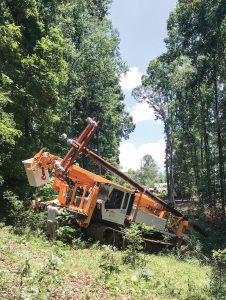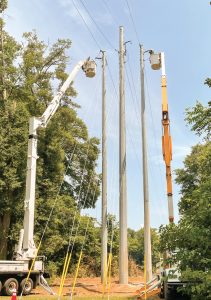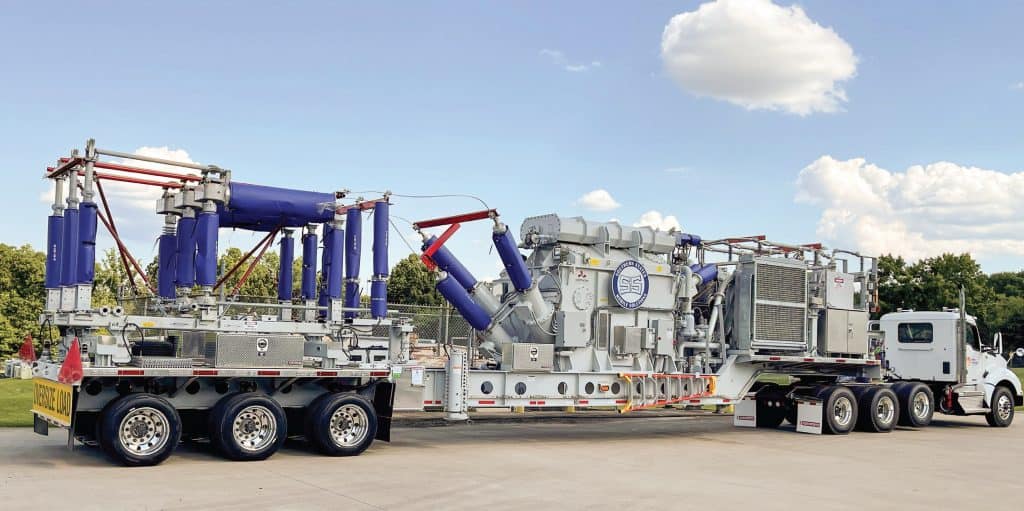New Horizon Electric Cooperative provides essential equipment for YEC, Upstate co-ops. To stand before them, one can be both intimidated and impressed. They are huge and often loud. They travel to remote locations, reach towering heights and are operated by skilled, courageous men. They perform challenging and often dangerous tasks whenever called upon.
But for all their horsepower and sophisticated machinery, the specialized equipment used by New Horizon Electric has a simple mission, according to York Electric Cooperative CEO Paul Basha.
“Can New Horizon do something more efficiently or cost-effective than we can do ourselves?” says Basha. “That’s the crux of why they exist.”
New Horizon Electric came into existence in 1998 to provide transmission to its five-member distribution electric cooperatives in South Carolina’s Upstate—York Electric, Broad River Electric, Laurens Electric, Little River Electric and Blue Ridge Electric. As the industry and intrastate partnerships changed over the last 23 years, so has the services of New Horizon Electric.

The Laurens-based cooperative no longer owns transmission lines, but instead provides maintenance for York Electric and the other member cooperative’s infrastructure—hence the need for track vehicles, 80-foot digger derricks and 125-foot knuckle boom bucket trucks. That work is mostly done hot, or without interrupting the flow of electricity traveling over those lines to York Electric and the other member cooperatives.
New Horizon Electric also provides construction, testing, inspections and maintenance for the dozens of substations serving electric cooperative members in the Upstate. It also manages the cooperatives’ supervisory control and data acquisition (SCADA) systems and other network monitoring, design and protection.
“As far as I can tell, New Horizon is the only entity like it in the country,” says CEO Bobby Smith. “We’re considered a G&T (generation and transmission), but we don’t have any energy sales. What we do puts us in a whole different bucket.”
In relation to outage restoration, New Horizon Electric most often works on transmission lines. However, when restoration or maintenance needs go beyond standard distribution line work, the New Horizon crews and equipment are dispatched.

In August, the crews were working on York Electric’s system, running a line across the Catawba River near the Riverwalk Trestle in Rock Hill. Smith says they even used a drone to fly a pull line approximately 1,040 feet across the river.
“That was about a two and a half week-long venture with our crews there with three steel pole structures on each side of the river,” recounts Smith. “It was distribution line, but we were using transmission size poles.”
Basha says the river crossing project is an ideal example of New Horizon meeting its mission.
“We would have to spend millions of dollars on equipment to complete that project, and then hardly ever use it again,” he says. “It makes more sense for them to do it, allowing for cooperatives to share the cost.”
Earlier in the year, a tree destined to fall was threatening one of York Electric’s main feeder lines, but it was in a swampy area of its territory.
“We couldn’t get our trucks in there,” says Basha. “They brought the swamp buggy, cut the tree and prevented an outage. Preventing an outage is less expensive than responding to one and it’s no inconvenience to the member.”
The “swamp buggy” is a Prinoth GT3000 track carrier with a digger derrick and bucket. It’s not brought out as frequently as one of the long knuckle boom trucks that can take the New Horizon lineworkers to the tops of transmission poles. But when a problem is hard to get to, it’s usually a part of the solution.
“Whatever the need is, we fill that gap however we can,” says Smith. “We could be out there trying to get the latest and greatest and coolest equipment, but the last thing we want to do is buy some million-dollar piece of equipment and it just sits down here.”
The dozer, diggers and boom trucks aren’t the only cool tools that the Upstate cooperatives share. New Horizon Electric recently purchased two mobile substations. Mobile substations are used to restore power to consumers when equipment is damaged at local substations. When substation maintenance would otherwise interrupt service to members in the area, a mobile substation keeps their power on. The purchase of one mobile substation would cost York Electric more than $1 million. Having access to New Horizon’s mobile substation saves their members money.
“Mobile substations, our vehicles, our facilities—all of that gets shared equally,” explains Smith. “We have an engineering committee that is represented by all five cooperatives that influences the equipment we purchase. Everyone agrees to it and the costs are shared.”
Smith adds that labor costs are billed directly to the cooperatives as New Horizon services are accessed.
“The bottom line is that if it wasn’t cost-effective for us to have New Horizon, we wouldn’t have it,” says Basha. “They’re there because they help us take great care of members. They’re a part of the whole equation that helps us look out for you, keep rates low and the lights on.”

BY JOSH P. CROTZER
